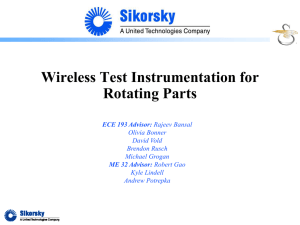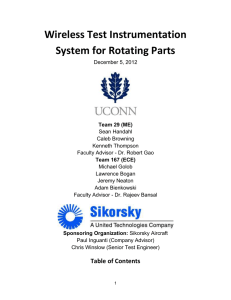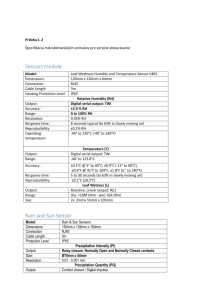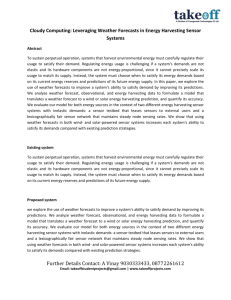Written Proposal - ECE Senior Design
advertisement
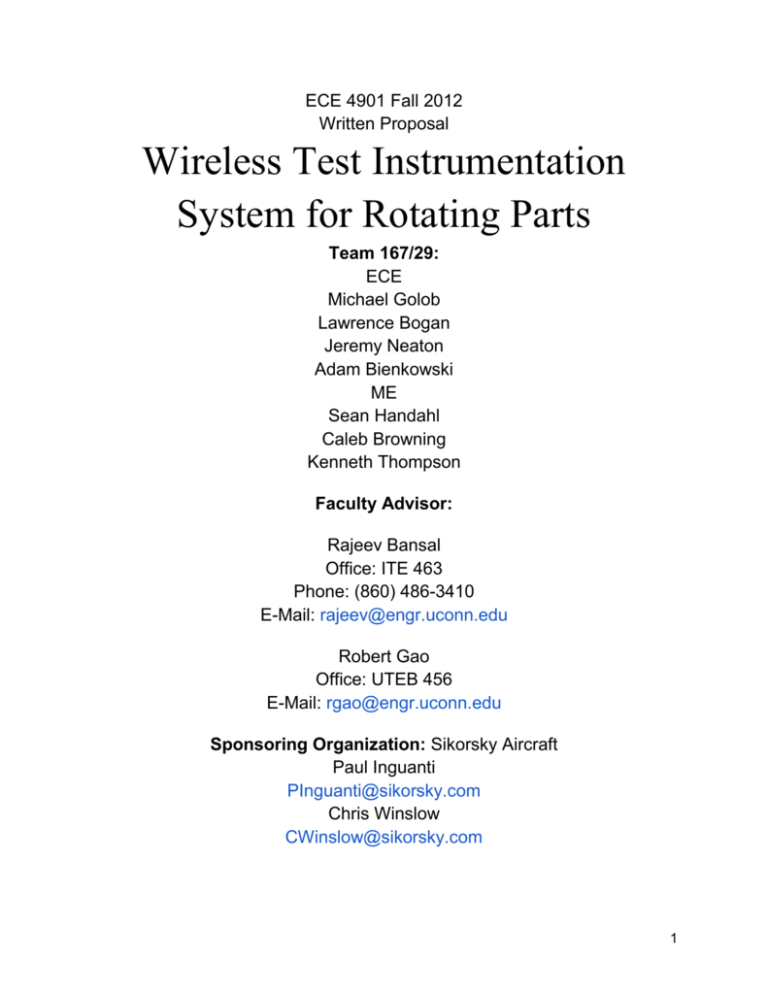
ECE 4901 Fall 2012 Written Proposal Wireless Test Instrumentation System for Rotating Parts Team 167/29: ECE Michael Golob Lawrence Bogan Jeremy Neaton Adam Bienkowski ME Sean Handahl Caleb Browning Kenneth Thompson Faculty Advisor: Rajeev Bansal Office: ITE 463 Phone: (860) 486-3410 E-Mail: rajeev@engr.uconn.edu Robert Gao Office: UTEB 456 E-Mail: rgao@engr.uconn.edu Sponsoring Organization: Sikorsky Aircraft Paul Inguanti PInguanti@sikorsky.com Chris Winslow CWinslow@sikorsky.com 1 Table of Contents 1 2 3 4 5 6 7 Executive Summary ________________________________________________ 3 Introduction ______________________________________________________ 4 Background __________________________________ 4 Specifications ___________________________________________ 4 Solution ___________________________________________________ 5 Budget _______________________________________________________ 10 Timeline _______________________________________________________ 10 2 1. Executive Summary Sikorsky, a United Technologies aircraft manufacturer, would like to solve a problem with monitoring pitch change bearings in the tail rotor of their helicopters. These bearings are located inside a shaft that rotates at up to 1200 revolutions per minute, and are crucial for keeping control of the aircraft during flight. However, their location makes it expensive and inconvenient to access for regular maintenance, and so pilots have relied on manufacturer data to attempt to predict when these bearings fail. The current system used for monitoring consists of a wired sensor with a slip ring, causing liabilities with wires failing due to breakage or from being shot off in a hostile environment. The slip rings also have brushes that add weight and eventually wear down. A team consisting of seven University of Connecticut engineers were given a 4000$ budget to find a wireless solution that would allow for the monitoring of these bearings over a minimum timespan of a year, without having to perform additional maintenance. More specifically, the team was asked to show that a wireless solution is feasible, and to test this information was given on the Sikorsky S-92 helicopter. The solution the team found for proof of concept was a Wireless Test Sensor System (WSN) that can monitor variables such as vibration or temperature of the bearing to indicate when the helicopter needs to be repaired. This WSN consists of a microcontroller, transceiver, and accelerometer that can record data to be transmitted to a stationary system, once a day, in the helicopter cabin up to 40 feet away. It will be capable of recording and storing data to memory, until the data is requested for evaluation, at which point the system will remove any onboard data. The WSN will be turned on by a wakeup signal in order to save power by only recording data while the helicopter is operational. It will all be powered by a battery, which will suffice to power the network for the one year minimum, and allow the system to power on after 30 days of inactivity, as requested by Sikorsky. However, the system may also include vibrational energy harvesting technology, which would boost the lifespan of the system past the minimum requirement for convenience. Furthermore, Sikorsky provided requirements on temperature, packaging, and size in order for the system to work inside the 1.5” by 5.1” lubricated electronics cavity of the shaft. The team’s final design meets all of these requirements except for temperature, because commercially available components do not meet the high end of the -20 to 250 degrees Fahrenheit range. However, it has been confirmed that there are military grade components that can be used, but that the team would not have access to them, and so the team will provide proof of concept and the company can further improve the design. It is predicted that the suggested WSN will accurately give readings on the vibration of the tail shaft, and will have no issues with the power supply over the entire time frame. In order to test this, the engineers also designed a test rig using a variable speed motor, an imitation shaft, and cartridge bearings to simulate the actual rotating conditions in the helicopter, and to allow for the collection of data of broken bearings and healthy bearings for comparison. If implemented into Sikorsky helicopters the WSN will provide a more accurate readout on the condition of this 3 bearing, improving the safety of all pilots and crews, and allowing for savings in maintenance for the company. 2. Introduction Sikorsky aircraft have typically used wired sensors to take measurements of critical systems. There are some problems associated with this method of monitoring, particularly when the measurements take place on a rotating part, in which case sliprings are used to connect between rotating and stationary parts. Mechanical failure of wires and connectors can lead to open or short circuits. Long wires add to the weight of the aircraft, and any weight added to the aircraft reduces the weight it can carry. If a suitable wireless system to collect and transmit sensor data could be developed, it would eliminate or reduce many of these issues. 3. Background This project will focus specifically on a wireless interface for sensors to monitor the tail rotor pitch change shaft bearing for signs of failure. Vibration has been shown to be a good measure that are good indicators of bearing status, with high vibration being indicative of bearing failure. This sensor will be on a rotating part, which means that in order to eliminate the need for sliprings and wires, the entire system to collect and transmit the sensor data, including a power source, must be contained within the rotating part. Sikorsky would like us to be able to measure the bearing, whether it is the temperature, vibration, or strain. We need to then process the measurement data by using a filter, and then digitize that data. The measurement data must also be able to be stored temporarily. This data needs to be transmitted to a stationary system where it can be accessed for analysis. The measurement system and the receiver must be powered, either by a battery or energy harvesting. The battery need to last a minimum of one year, but should be three years. The battery needs to be able to still give power after thirty days of inactivity, and be able to collect data for up to twelve hours per day. 4. Specifications Electronics Compartment: • Size: 1.5” diameter x 5.1” long • Temperature: -20 to 250 degrees F Rotating Speed of Tail Rotor Shaft • 1200 RPM Battery Life • 1-year min (3 years recommended) • Runs for 12 hours a day, needs to survive 30 days of inactivity Data Processing • Measure vibration • Store data temporarily 4 • Transmit to stationary system and available at request of user • Data must travel wirelessly upwards of 40 ft. Environmental Parameters • Can’t be visible from outside (hostile environment) • Cavity is oil lubricated • Moisture Possibility • High vibration level 5. Solution Generic Block Diagram Technical Specifications: Wireless transceiver: The ZigBee chip will be used as our wireless transceiver to transmit data from the measuring system, which is located within the tail rotor to the stationary receiver that will be located in the cabin. We chose to use this as our wireless interface for two main reasons. The first main reason is that it consumes only 14 milli amperes, which is very low power consumption in our design. In sleep mode, it only consumes .02 microamperes, which in return, only saves us more power. The second main reason is the fact that it can transmit data over a very far range and at even a far more range than what is required in our parameters. However, these two reasons were ideal in selecting the ZigBee chip as our transceiver. Part No. Operating Temperature Transmission Current Idle Current Voltage Max. Data Rate AT86RF231 -40°C to 125°C 14 mA 0.02 µA 1.8-3.6 V 2Mbp/s AT86RF233 -40°C to 85°C 13.8 mA 0.02 µA 1.8-3.6 V 2Mbp/s These were two transceivers that we considered and looked into. We selected the AT86RF231 primarily because of the operating temperature. The specifications for these parts 5 were nearly identical, but we also needed to satisfy the temperature parameter so this part was selected. Sensor: The sensor will be used to measure the vibration of the bearing. The defect frequencies we calculated occurred between 156Hz and 274Hz, meaning we needed a sensor with a bandwidth above 274Hz. The sensor needed to have an interrupt in order to tell the microcontroller to start recording data. By keeping the microcontroller in idle, we are able to save more power. We needed the sensor to have a very low power consumption, to preserve the battery. Part Number Voltage Idle Current 1.71V-3.6V Active Current 11μA LIS3DH SCA3060-D01 KXTIA-1006 Size Bandwidth Measurement Range Temperature 3.0V-3.6V 1.8V-3.6V 150μA 325μA 0.5μA 3 x 3 mm 2.5kHz ±2g, ±4g, ±8g, ±16g -40°C to 125°C 5μA 10μA 7.6 x 8.6 mm 3 x 3 mm 100Hz 1.59kHz ±2g ±2g, ±4g, ±8g -40°C to 105°C -40°C to 85°C Trying to find a sensor with an interrupt limited our options for accelerometers. The sensor we choose was the LIS3DH. The three sensors above all have interrupts and are among the three best options we could find. The LIS3DH accelerometer had an extremely low current consumption, which help us have lower power consumption. This was the main factor we looked into when deciding upon the sensor. We had a tight constraint on the power we have available, so we needed to save power where we could. The sensor we choose also is very small and allows us to operate at the 3.6V the battery provides. As discussed in the background we needed a bandwidth that was above 400Hz. The sensor we choose allows us to choose a wide range of bandwidths below 2.5kHz. Compared with the other two sensors, our sensor was the only one that satisfied the temperature constraints given to us. Memory: Memory will be needed in addition to the memory in the microcontroller to store data from the sensor. The size of the memory is limited by the power restriction, as higher capacity memories use more power. The amount of raw sensor data collected between data accesses is much more than the maximum memory size possible with the power restrictions. There are several methods to reduce the amount of memory needed. The first is to use a technique called time synchronous averaging, which involves averaging consecutive sets of samples together. In this case, only the average of a series of samples needs to be stored, which will greatly reduce the memory need. Another method is to sample for short periods of time with time in between samples when no data will be collected. A third method will be to transmit the data whenever the memory is full. With this solution, the full data will be stored on the receiver system, on a non-rotating part of the aircraft, which will have less strict power restrictions, allowing for a larger capacity memory. Part Number CY62167DV30 CY62177EV30 Voltage 2.2-3.6 V 2.2-3.7 V Active Current 2 mA 4.5 mA Idle Current 10 µA 17 µA Capacity 16 Mbit 32 Mbit These are two options for low power SRAM. The 16 Mbit option was selected because 4.5 mA is too high to meet the battery life specifications with the chosen battery. None of the 6 memories researched met the given temperature specification, because military temperature rated parts are not commercially available. Microcontroller: Part Number MSP430G2332-EP MSP430F5438IPZR Supply Voltage 1.8-3.6 2.2-3.6 Active Current 220 μA 312 μA Idle Current Size Operating Temp Program Memory IO pins .5 μA 2.6 μA 6.6x6.6mm 14x1.4mm -40 to 125 deg C -40 to 85 deg C 4kB 256kB 16 83 The lower power consumption option out of these two does not have sufficient program memory or input/output pins to meet our needs. The microcontroller we chose has slightly higher power use, but has enough program memory and input/output pins. Both of these support Serial Peripheral Interface (SPI), which is needed to interface with the sensor and the ZigBee transceiver. Battery: Our calculations for current use using the parts discussed above are as follows: Part Data Acquisition Current Transmission Current Idle Current Sensor 11 µA 0.5µA 0.5 µA Memory 2mA 2mA 22µA Microcontroller 312µA 312µA 2.6µA Transceiver 0.02µA 14mA 0.02µA Totals 2.32mA 16.31mA 25µA Assuming time synchronous averaging or periodic sampling, 16Mb transmitted at 2 Mbps once daily = 8 sec of transmission time per day. 2.32mA*12 hours/day*365 days/year = 10161.6 mAh 16.31mA*8sec/day * hours/3600 sec*365 days/year = 13.23mAh 25µA*12 hours/day*365 days/year = 109.5mAh Total = 10284.33 mAh Assuming periodic transmission, transmit when memory is full: 16 bits/sample*1.25kHz sampling frequency*3600sec/hour*12 hours/day =864Mbit/day 864Mbit/day2Mbps transmission rate =432sec/day transmission time 16.31mA*432sec/day * hours/3600 sec*365 days/year = 714mAh New total capacity needed = 10284.33+714+13 = 11011 mAh The 11.011Ah we calculated is the absolute maximum needed. We calculated based on the parts running continuously over the 12 hours. For periodic sampling, the memory will not be running for the amount of time used in these calculations, reducing the power used. 7 Battery model Dimensions Capacity Output Voltage Operating Temps Eaglepicher LC 3155 Diameter 30.7 mm (1.21”) height 54.6 mm (2.15”) 12.7Ah 2V -30C to 50C Eaglepicher LC 3355 Diameter 33.3 mm (1.31”) height 54.6 mm (2.15”) 15.5Ah 2V -30C to 50C 3.6V -55C to 125C Tadiran 15-5930-yy505 Diameter 32.9mm Height 61.5mm 17Ah From the batteries above, we choose the Tadiran 5930. Although most of the batteries we found were the correct dimensions, we found one that met the capacity we needed. The output voltage of 3.6V satisfies the voltage requirements of our components, while the 2V from the other batteries does not. Energy Harvester: Without energy harvesting, our design meets the minimum requirements for how long the battery will last. We will continue to research ways to add energy harvesting to our design to further extend the life of the battery. Vibrational energy harvesting is the most feasible solution with our system. Piezoelectric vibrational energy harvesting is the best option for energy harvesting for our system. Temperature based energy harvesting is not viable because the system lacks a reliable temperature gradient. The output of the vibrational energy harvester is sinusoidal or alternating current. A rectifier board is used with this system to take this alternating current and convert it into direct current that can be used throughout the system. Commercially available rectifier boards are too large to fit inside the small cavity available, so in order to use energy harvesting a custom board must be made. This custom board will need to contain a rectifier and a charge pump, to output a DC voltage at the same level as the battery. If a custom rectifier board cannot be created to accompany the energy-harvesting device, then the system will be powered solely by the battery and will reduce the total operating time. Test Rig: The main focus of the project lies with the electronic component selection and making sure that they work. In order to do this, a representation of a tail rotor shaft with the electronics cavity at the tip will have to be produced. This cavity is the only space currently available in the helicopter’s design for emplacing all the required components. The final test rig model will be created in Siemens NX8 computer aided design modeling software. The rotating shaft will be powered by an electric motor, which will also be the source for the natural vibrations induced to the system. The level of vibrations is motor dependent and can be adjusted by adding offset mass to the rotating system in order to get the amplitude of the vibrations to an acceptable level for measuring. This motor will have an adjustable speed controller to allow for the testing of sensor readings at various speeds. 8 The vibrations of the test rig would ideally try to match those of the S-92 in terms of gforce, magnitude and frequencies, but this data cannot be obtained from Sikorsky. These are the natural vibrations of the system due to the engine, rotors, and transmission operating during flight. A spherical roller cartridge bearing and an angled roller cartridge bearing will support the rotating shaft. These two bearing types mimic those in which the actual tail rotor shaft rotates in, with the pitch change bearing being the spherical roller type and the shaft support closer to the blades being the angled roller type. The cartridge type allows for them to be removed and switched out with a purposely-damaged set. These will allows us to see how the vibrations of the system are altered when the bearings do go bad. The requirement of this project is to be able to analyze and transmit the data, not necessarily to distinguish between the readings obtained from a good bearing and that of a bad bearing. However, this will allow for a meaningful demonstration of the effects the bearing’s condition has on the system and readings. Current Block Diagram 9 6. Budget: ● Battery (x4): $100.80 ● Sensor: $2.27 ● Transceiver: $5.16 ● Microcontroller: $9.86 ● Memory: $15.75 ● Antenna: $5.19 ● Balun: $2.58 ● Programmer: $70.54 Total: $212.15 7. Timeline 10
